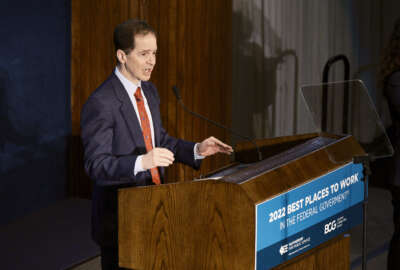2023 Best Places to Work marks a turning point in employee engagement
Beyond just the rankings of the 2023 Best Places to Work in the Federal Government, there appears to be a broader atmospheric shift for the federal workforce.
When seeing the Best Places to Work in the Federal Government results this year, many agencies may be breathing a sigh of relief.
It’s not necessarily because of where they landed in the rankings. Rather, it’s because there appears to be a broader atmospheric shift for the federal workforce.
The Partnership for Public Service and Boston Consulting Group released the 2023 Best Places to Work results Monday. In analysis that comes alongside the rankings, the Partnership’s governmentwide measure of engagement and satisfaction rose for the first time in four years. The index score is now 65.7 out of 100, a 2.3-point increase since last year’s rankings.
Before this year’s results, there had been several consecutive years of declining scores in the Best Places to Work series. The Partnership even called the 2022 rankings a “warning signal” for agency leaders. But Partnership President and CEO Max Stier said the latest analysis holds much more promise.
“Any organization should understand that employee morale is the most important ingredient for improved performance,” Stier said Monday on The Federal Drive with Tom Temin. “This is not about happy employees. This is about better-performing organizations and better mission achievement.”
Like Stier said, engagement and satisfaction aren’t really a measure of how “happy” federal employees feel. Instead, it depicts how federal employees view both their agencies and their jobs. It looks at how employees perceive their work environment and their leaders. The Partnership bases the index on questions such as “how likely am I to recommend my agency as a good place to work?” and “how much satisfaction do I get out of my job?”
For the 2023 Best Places to Work, more than two-thirds of agencies either maintained or increased their engagement and satisfaction scores. By comparison, in the 2022 Best Places to Work results, only a quarter of agencies had those same results.
It’s hard to point to a single reason causing the tone shift this year, and it may vary depending on the agency.
But one throughline was the impact of returning to the office. In the 2023 Best Places to Work, employees who teleworked full-time had the highest engagement and satisfaction scores, at an average of 74.6 out of 100. By comparison, employees who work in headquarters offices and at field offices scored 69.2 and 61.7 on the same scale, respectively.
The Partnership largely derives its analysis from Federal Employee Viewpoint Survey (FEVS) data. Notably, the 2023 FEVS collected responses from feds prior to many agencies’ return-to-office changes over the last several months.
From the 2023 results, it’s also clear that federal employees want their voices to be heard even more. Some of the lowest-scoring areas in the Partnership’s measurements of work-related issues were employee input and employee recognition. Those areas received scores of 56.3 and 53.9 out of 100.
Although the score is relatively low, there have been some improvements in employee confidence, the Partnership said. For the 2023 FEVS, employees gave their agencies a score of 47.7 out of 100 on the question of whether they believed the results of the survey would be used to make their agency a better place to work. It’s almost always the lowest-scoring FEVS question. But employees’ score this year represents a nearly 5-point increase since the 2022 results.
The Partnership also measures leadership, recognition, work-life balance, pay, and diversity, equity, inclusion and accessibility. Employees reported the highest scores on how connected they feel to agency mission. That measurement received a score of 73.3 out of 100.
Ups and downs of 2023 Best Places to Work rankings
Now for the 12th year in a row, NASA has maintained its number one spot as the best large agency in the government. Also topping the lists are the Government Accountability Office, the National Indian Gaming Commission and the Pension Benefit Guaranty Corporation’s Office of Negotiations and Restructuring. They earned the number one spots for midsize agencies, small agencies and agency subcomponents, respectively.
But for Stier, year-to-year score improvements within an agency are just as important as ranking high up on the list, if not more so.
“There’s a tendency in the government space for everyone to look for what’s broken, rather than what’s there that can fix what’s broken,” Stier said. “In addition to those that are at the top, [we also celebrate] those that are most improved because we think that direction matters. Any leader that is able to move their agency up in a consequential way should be celebrated.”
Many agencies saw significant advances in employee engagement. The Consumer Product Safety Commission earned most improved award for small agencies. And the DoD’s Defense Technical Information Center posted an almost 23-point boost since last year.
Midsize agencies had the highest engagement and satisfaction scores of any grouping. The Federal Trade Commission and the National Labor Relations Board were the two midsize agencies with the largest score improvements, with increases of 8.1 and 7.6, respectively. The National Credit Union Administration, Office of Personnel Management and U.S. Agency for Global Media all saw more than 4-point increases.
Among hundreds of agency subcomponents, even at the very bottom of the list, the Federal Bureau of Prisons saw its score go up by 2.6 points since 2022.
At the same time, a little under a third of agencies in the rankings still had declining scores. The Social Security Administration ranked last place for large agencies. SSA’s score decreased by 1.8 points, now down to 52.1 out of 100. The National Science Foundation and the Federal Deposit Insurance Corporation both faced 6.5-point drops. Scores for the Merit Systems Protection Board, Export-Import Bank, Millennium Challenge Corporation and International Development Finance Corporation all declined by double digits.
“For an agency that’s at the bottom, it’s hard to turn those [scores] around,” Stier said. “It’s a lot easier to keep a healthy culture going and growing, than it is to bring an agency that is hurting out of the hole that’s been dug.”
That’s not to say it’s impossible to make positive progress after years of struggling. As an example, the Department of Homeland Security had ranked dead last in the Best Places to Work every year since the Partnership first created the series. That was, up until last year. DHS is now in 14th place out of the 17 large agencies, and it has the most improved score for large agencies this year. The Transportation Security Administration, a subcomponent of DHS, also saw its most significant score increase in the history of the Partnership’s rankings. TSA’s score climbed up by 12.3 points.
The departments of Interior and Veterans Affairs, as well as the Army, all saw large score increases as well.
“What good leaders would do would be to recognize and learn from the leaders in the places that are doing better, and provide help and support to those that are that are at the bottom,” Stier said.
The Partnership is hosting a breakfast ceremony Monday morning to recognize the top-ranking agencies, as well as the most improved agencies, in Washington, D.C.
Copyright © 2024 Federal News Network. All rights reserved. This website is not intended for users located within the European Economic Area.
Drew Friedman is a workforce, pay and benefits reporter for Federal News Network.
Follow @dfriedmanWFED






